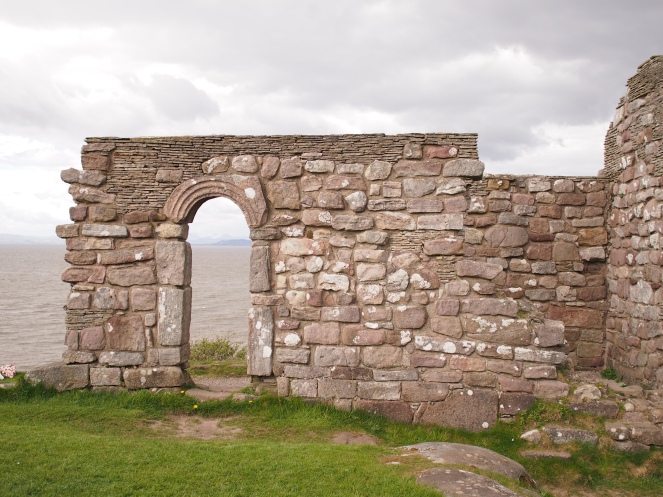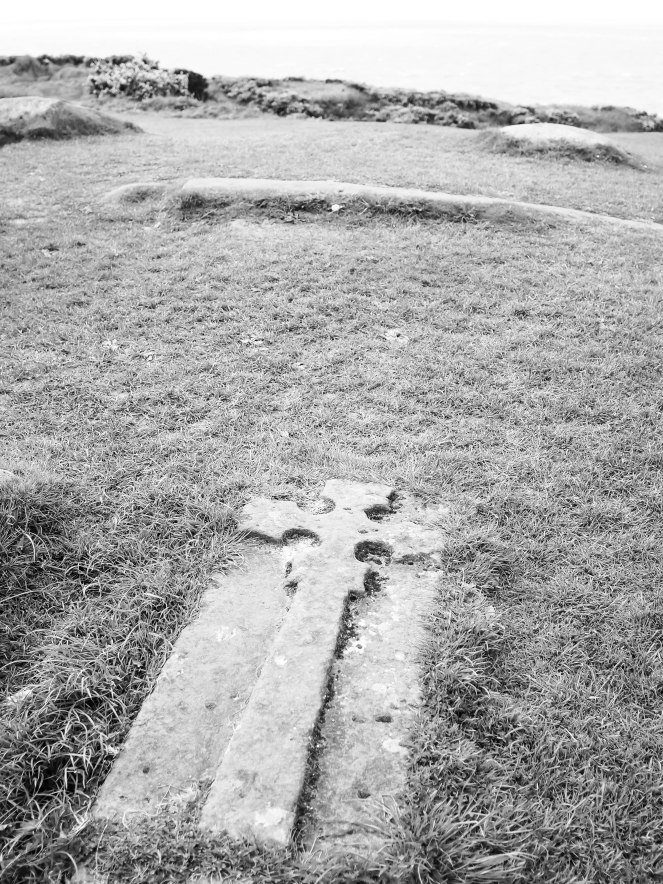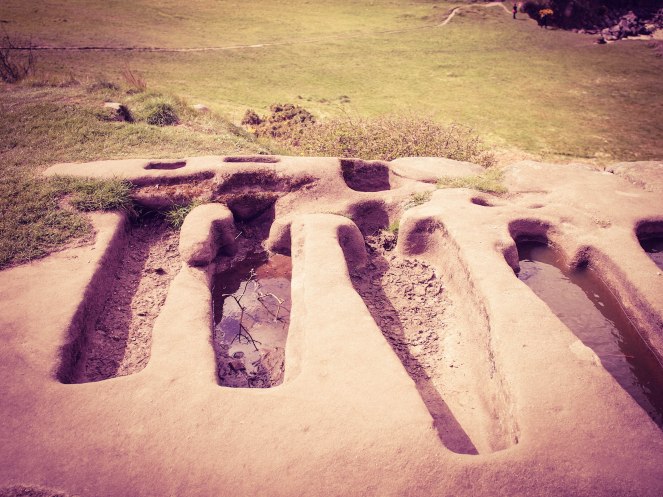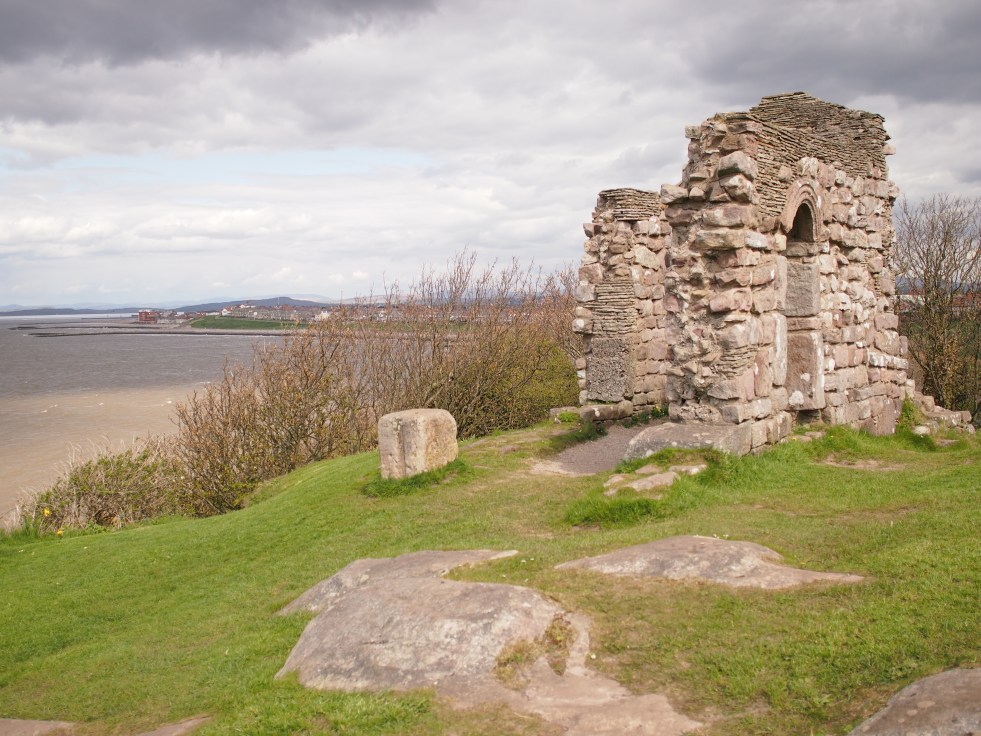Regular readers of this blog will know that I’m especially interested in particularly old and unusual graves, and the subject of today’s post definitely falls into that category. On the windswept Lancashire coast, six graves carved into solid rock have survived for over 1,000 years, remarkable survivors at an ancient site where it is thought that pilgrims came to venerate St Patrick in the Anglo-Saxon period. These are the rock-cut tombs of Heysham, some of the finest relics of early Christianity to be found in the north west of England.

Recently, whilst up north visiting family, a couple of friends and myself caught a bus from Lancaster into Heysham, taking a roundabout route through countless anonymous modern suburban streets and housing estates, before suddenly arriving in a much older place. Heysham village clings to the edge of a little headland jutting out into the Irish Sea, with a few streets of houses dating back to the seventeenth century nestling around the village’s ancient core. These days Heysham is better known as being a ferry port with services to and from the Isle of Man and Ireland, and as the location for two nuclear power stations. But located by the cliffs at the edge of the village are some fascinating relics of the area’s early Christian past.
When walking through Heysham village towards the sea, the first ancient place you reach is the church of St Peter, which has its origins in the Saxon period and is home to a beautifully-preserved Viking-era hogback stone – which sadly we didn’t see, as the church was locked when we visited.

Founded in the 7th or 8th Century, the fabric of St Peter’s church still contains some of the original Saxon building, despite many extensions, alterations and renovations over the centuries. It’s a fascinating place that really deserves a blog post of its own to delve into its long history. As well as the aforementioned hogback stone, another fragment of the pre-Norman era survives – the base of a carved Anglo-Saxon cross, still situated in the churchyard.


Surrounding the church of St Peter is a large graveyard, populated with headstones mostly dating from the 19th and 20th Centuries. The burial ground slopes down towards the sea – it’s a bleak but ultimately beautiful spot to be laid to rest.

Just beyond St Peter’s and its churchyard a narrow path leads through a stone arch onto the windswept cliff top. This is another very old Christian site, the location of the chapel of St Patrick, now a ruin, which is thought to have been founded in about the 8th Century. Historic England describes the site as “one of the best examples in north west England of an early Christian chapel and cemetery.” Climbing up the path to the chapel’s ruins, you can almost imagine pilgrims taking the same route, emerging onto the cliff top with the wind in their hair, impressed by the sturdy stone chapel there and the far-reaching views of sea and mountains.

St Patrick, of course, is most closely associated with Ireland, the country he is patron saint of. But he was not born in Ireland, and it’s been suggested that he may have hailed from Ravenglass, a town founded by the Romans on the Cumbrian coast. The legend goes that when returning to his native Britain from Ireland, St Patrick was washed ashore at Heysham, close to the site now occupied by the ruins of the chapel. There is no way of telling whether there is any truth in this story, or whether the link with St Patrick was exaggerated to encourage pilgrims to visit the chapel. St Patrick lived in the 5th Century, but there is no evidence of a chapel existing at Heysham before the 8th Century. It is thought that the chapel fell out of use some time after the Norman Conquest, at around the same time that neighbouring St Peter’s church was enlarged.

The rock-cut tombs are the real star of the show here – they even featured on the album cover of Black Sabbath’s greatest hits in 2000. Six tombs, dating from the 10th Century, have been cut into a huge block of solid rock – four of them body-shaped, the other two having straight sides. At the head of five of these graves is another smaller hole, thought to be a socket where wooden crosses were placed to mark the graves. No bones remain in the tombs today, and it has been speculated that the tombs might not have been for the purpose of new burials, but were created to hold older bones and relics. The creation of these graves would have involved a lot of labour, so it makes sense that they were carved out to hold particularly precious, important remains. The identities of those whose remains were placed here have been lost to history, so we can only speculate about who they were and why they were afforded the privilege of these special graves.


Although whatever bones were deposited in the rock-cut graves are long gone, a large number of burials have been recorded nearby. In the 1970s, excavations at the site revealed around eighty burials in the immediate vicinity of the chapel, with some even being found within the chapel walls. Radiocarbon dating done on three of the burials suggested that those individuals had died sometime between the 10th and 12th Centuries. Who were the people buried here? Were they locals, or devotees of St Patrick who chose to be buried at a site associated with the saint? It is unclear exactly what purpose the chapel served, so close to another church. It may have been the private chapel of someone powerful, or it may have been part of a monastic set-up. Archaeologists also discovered fragments of painted plaster at the site, suggesting that at one time the chapel was decorated with colourful images.

The site of the chapel and the rock-cut graves actually has a history going back much, much further than the Saxon period. Archaeologists working close to the site of the rock-cut graves in 1993 discovered a large number of artefacts, some of which dated back as far as 12,000 years ago, so clearly this site has been an important one to people living in the area for a very long time. There is a commanding, dramatic view across Morecambe Bay, with views of the mountains of the Lake District possible on clear days. I found myself quite in awe of the site, despite the biting cold wind and the threat of rain. It’s a breathtaking spot and it is no surprise that people have been drawn to it for thousands of years.

The people whose bones were placed in the rock-cut graves by St Patrick’s chapel are long gone, their names and stories forgotten, but the site remains one that continues to draw interested visitors. I think part of the draw to the site is its mystery – so little is really known about it, but its great age and the intriguing ruins that remain there provide ample fuel for the imagination. It’s a rare tangible link to a mostly-forgotten period of Lancashire’s past, a time when Christianity was gaining a foothold in Britain and inspiring people to build churches and stone crosses to demonstrate the strength of their faith. Heysham continues to celebrate its past, with the very first Heysham Viking Festival scheduled to take place in the village later in 2016.


References and further reading
The ruins of St Patrick’s Chapel stand beside Morecambe Bay in north-west England http://poppy.nsms.ox.ac.uk/woruldhord/attachments/1887/280.1887.original.htm?1286678254
St Peter’s History – Heysham Parish (PDF) http://www.heyshamparish.org.uk/hp/p_history.pdf
St Patrick’s early Christian chapel and associated cemetery, Lower Heysham – List Entry, Historic England https://www.historicengland.org.uk/listing/the-list/list-entry/1020535


Wonderful post! It was here where my graveyard tour on BBC Radio Lancashire took place last year.
LikeLike
Fascinating post!
LikeLike
Love this one. It transported me back home!
LikeLike
Loved this! It reminded of the old church in Gosforth in Cumbria, which has a Norse cross covered in pagan carvings standing in the churchyard and some hogback gravestones standing inside the church itself. They are apparently unique, I suppose because of the warriors forming a shield wall carved on the side. It would have been impossible for Viking shields to connect from top to bottom in the way they’re shown.
LikeLike